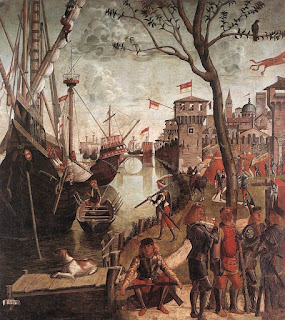 |
| The Arrival of the Pilgrims in Cologne |
The painting The
Arrival of the Pilgrims in Cologne is the seventh painting in the series of Stories
from the Legend of St. Ursula. In the painting, you can see one of the ships
docked while the other ships of the retinue are still waiting in the bay. You
can also see Ursula and Pope Cyriacus and leaning over the ship asking
questions of the boatman. Armed guards and lots of activity make their appearance
in this busy port.
The painter Vittore
Carpaccio was born in Venice to a leather merchant. Not much is known about his
life other than he painted a number of great works. The Legend of St. Ursula is
one of his best works that depicts a story. Each painting marked a particular
place and scene in the legend. These types of series paintings would require a
number of years of study and research.
The paintings
depict Ursula who was a 5th century daughter of an English King.
According to the legend, a Hun king asked for the hand of Ursula for his son Ethereus
and threatened to invade England if the English king refused. The English king
in his wisdom agreed but with a number of conditions which included 10 females
to accompany the princess, three years of prayer for Ursula, and a thousand
females for each of the 10 women accompanying the princess.
Ursula converted
all of the ladies to her religion Christianity. She received a message from an
angel that she and her new friends would become martyrs in Cologne. Apparently,
the pope also received the same message from the angel and he too went with
Ursula to support her. The suitor Ehereus amazingly also received the message
and went to Cologne to join the party.
Once in Cologne the
Huns attempted to take advantage of the girls. Due to their new faith, the
women resisted their advances. Apparently, Julius, a Hun leader, instructed to
have all of her companions killed. This included Ethereus. Julius attempted to save her life but when she
refused his marriage offer, he threw an arrow and hit her in the heart thereby martyring
her. A new group called the Ursulines started in 1535 Italy to commemorate her
beliefs.
Regardless of your
particular religious leanings, you can appreciate the story as one interest and
value. The series of paintings is a beautiful example of the Venice Renaissance
and maintains a touch of humanism. There were a number of paintings by other
artists of this event. You may read about the artists and the legend below.
No comments:
Post a Comment